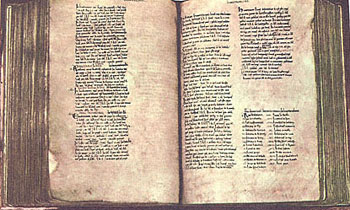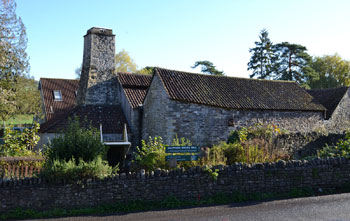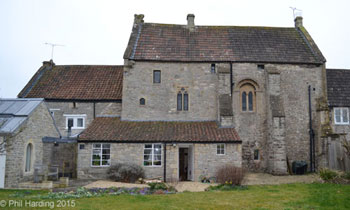SEG Home > History of Saltford > A - Z > Domesday Book
The History of Saltford
The Great Domesday Book, 1086

The entry for Saltford in the 1086 Domesday Book.
Following William the Conqueror's victory over King Harold of England at the Battle of Hastings in 1066, there were many revolts, land seizures and quarrels over land ownership. The Domesday survey was launched in 1085 by King William at Christmas in Gloucester to settle all quarrels and disputes whilst at the same time to take stock of his new kingdom.
Groups of men, the "Commissioners of Domesday", were sent out all over the country (much of England and parts of Wales) to find out who owned the land in each county and asses how ownership had changed since 1066. This survey produced the Great Domesday Book of 1086, a single volume of all the books of each area.
The book got its name from the way information collected and recorded in manuscript was held as final and without appeal. This led people to compare it to the Last Judgement, or 'Doomsday', as described in the Bible, because its decisions, like those of the Last Judgment (Revelation 20:12), could not be changed.
The word Domesday is Middle English (1150-1500) for Doomsday (Oxford English Dictionary 3).
Today the Domesday Book is held in the National Archives at the Public Records Office in London. It provides us with a fascinating insight into the economy and society of 11th century Norman England.
We have provided a translation here of the entry in the Great Domesday Book for Saltford as well as some thoughts on Saltford's entry by Dick Bateman.
English Translation
Roger holds SALTFORD from the Bishop (?Geoffrey of Coutances). Four thegns held it
in the Time of King Edward and paid geld in equal shares for 4 hides. Land there for 6 ploughs. In the lord's land / demesne are
3 ploughs and 6 serfs and 7 villeins and 10 bordars with 4 ploughs.
There is a mill paying 12 shillings and 6 pence and 32 acres of meadow. It was valued at and is (now) worth 6 pounds.
Medieval Terms
Bordar: A Bordar (or Cottager) ranked below a serf in the social hierarchy of a manor. He held only a cottage, a garden and just enough land to feed a family.
Demesne: All the land, not necessarily adjacent to the manor house, retained by a lord of the manor for his own use and under his own management. This land was usually worked for the Lord of the Manor by his villeins.
Geld: A tax paid by the land holder and usually based on each hide of land that was held.
Hide: An area of land sufficient to support a family. It was not a fixed area but a measure of value. In the 11th century land that produced £1 per annum in tax was generally assessed as 1 hide.
King Edward: Edward the Confessor; lived c.1003/5 to 1066 and reigned 1042 to 1066. He was succeeded briefly by Harold II (Harold Godwinson) who lived c. 1022 to 14 October 1066. Harold was the last Anglo-Saxon King of England. He reigned from 6 January 1066 until his defeat by William at the Battle of Hastings on 14 October 1066.
Plough: An area of land that could be ploughed by a team of eight oxen in one year, usually estimated at about 120 acres.
Serf: A serf resided upon and worked a parcel of land within the lord's manor in return for protection. He did not own the land that he worked on, but was not a slave.
Thegn: Either an aristocratic retainer of a king or a nobleman in Anglo-Saxon England.
Villein: Villeins had more rights and higher status than the serfs, but were not freemen. They generally rented small homes, with or without land. They were expected to spend some of their time working the lord's land without pay.
Abbreviated Medieval Latin Text
(as in the Domesday Book entry pictured on this page)
Rogeri ten de epo SANFORD. Quattuor taini tenure
T.R.E. et gelat p. iiii. hid. Tra. ei. vi. car. In dnio st
iii. car. et vi. servi. et vii villi et x. bord cu. iiii car.
Ibi molin reddt. xii sol. et vi. den. et xxx.ii ac pa.
Valuit et val. vi. lib.
Expanded Latin Text
Rogerius tenet de episcopo SANFORD. Quattuor taini tenuerunt
Tempore Regis Edwardi et geldebant pariter 1111 hidas terra ei vi carucatas. In dominio sunt
iii carucatae et vi servi et vii villani et x bordarii cum iiii carucatis
Ibi molindarium reddentur xii solidis et vi denariis et xxxii acrae prati.
Valuit et valet vi libri.
Translation by Richard Stabbins & Jerome Farrell, January 2015
Return to top of page
Thoughts on Saltford's entry in the Great Domesday Book
Dick Bateman, 10 March 2015

The entry for Saltford in the 1086 Domesday Book.
Entry: "Roger holds SALTFORD from the Bishop (?Geoffrey of Coutances). Four thegns held it in the Time of King Edward and paid geld in equal shares for 4 hides. Land there for 6 ploughs. In the lord's land / demesne are 3 ploughs and 6 serfs and 7 villeins and 10 bordars with 4 ploughs.
There is a mill paying 12 shillings and 6 pence and 32 acres of meadow. It was valued at and is (now) worth 6 pounds."
"Roger now holds the manor (meaning 'area of land') of Saltford, appointed by the Bishop (possibly Bishop Geoffrey of Coutances who had been given huge areas of land in the West Country by King William The Conqueror)"
Before The Conquest, four thegns (landholders) held Saltford during the Time of the (Anglo-Saxon) King Edward (Edward 'the Confessor' who ruled from 1042 to 1066, the date of the Conquest).
Each of those landholders paid a land tax of one hide (£1) to their lord of the manor, four hides (£4) in total.
Their land in Saltford was for 6 ploughs (a variable area but up to 120 acres per plough), so 720 acres (291 hectares or almost 3 square km) in total. In the Lord's lands are three ploughs and...
6 serfs (the lowest form of villager, had to work Roger's land, could be bought and sold and could not leave Roger's land without permission) and...
7 villeins (villagers who were allocated their own land by Roger (up to 30 acres in some manors) but had to work some days without pay on Roger's land, fight for him, and could work in their spare time on land they rented from him) and...
10 bordars (a lower form of villager but above a serf, each with a tiny cottage and about 1 acre of land (approx. the size of a small football pitch without surrounding run-off area) to feed a family. Like the villeins they had to work on Roger's land without pay and this took most of their time ) with 4 ploughs.
So the 6 serfs worked the three ploughs (up to 360 acres) of Roger's land without pay.
The 10 bordars and 7 bordars shared 4 ploughs (up to 480 acres) between them. If shared out equally this would have been up to 28 hectares each (1 hectare = 100 metres x 100 metres).
There is a mill (a water mill, as no windmills were built for another 100 years) paying 12 shillings and 6 pence (62.5p) tax per year and 32 acres of meadow (grazing land by the river).
The mill was valued at 6 pounds before the Conquest and has the same value now.
Note on villeins, bordars and serfs:
(www.bbc.co.uk/history/british/
normans/doomsday_01.shtml)
Of the 268,984 individuals described in Domesday, some 40 per cent are listed as villani. This Latin term has been translated in different ways by historians, as villain, villager, and villan. Philip Morgan has described them as "simply members of the vill who held a fixed share of its resources, including a changing pattern of strips
within the fields, and owed labour services to the lord's demesne" (land held directly by the lord of the manor). Some might have farms of as much as 30 acres, but still owe their lords two or three days' work on his land. Below them in the social hierarchy came the bordars, who owed more services but held less land and below them the
cottars, with even less, perhaps just a few acres and a vegetable garden. Sometimes those with trades - millers, blacksmiths, potters, shepherds and the like - receive specific mention and are named such as Fulchere the Bowman. Others appear with names associated with more personal characteristics, such as Alwin the Rat and Ralph the Haunted.
At the bottom of the social pile came the servi, who were bound to the land they worked on or to the lord who owned the land. This represented about 10% of the total population, they had no property rights and could be bought and sold with the land to which they were bound.
The Great Domesday Book commissioners were told to find answers about land and possessions in each Manor they visited.
An inquest in Ely, in Cambridgeshire, lists these questions asked by the commissioners, and the Saltford answers seem to be
similar:
(www.bbc.co.uk/history/british/
normans/doomsday_01.shtml)
- What the manor was called
- Who held it at the time of King Edward
- Who holds it now
- How many hides there are (measurement of land for taxation purposes, between 60 and 120 acres)
- How many ploughs held by the lord and how many belonging to the peasants
- How many villeins (the wealthiest of the unfree peasants who had to pay his lord labour service and rent)
- How many cottars (an unfree peasant with a holding of land up to 5 acres)
- How many slaves (unfree man or woman)
- How many freemen
- How many sokemen (equivalent to a freeman but owing dues to his lord for his holding)
- How much woodland
- How much meadow
- How much pasture
- How many mills
- How many fisheries
- How much had been added to or taken away from the estate
- What it used to be worth altogether
- What it is worth now
Dick Bateman, 10 March 2015

© Saltford Environment Group
W3C compliant website. Web page designed and produced by Phil Harding.
|







